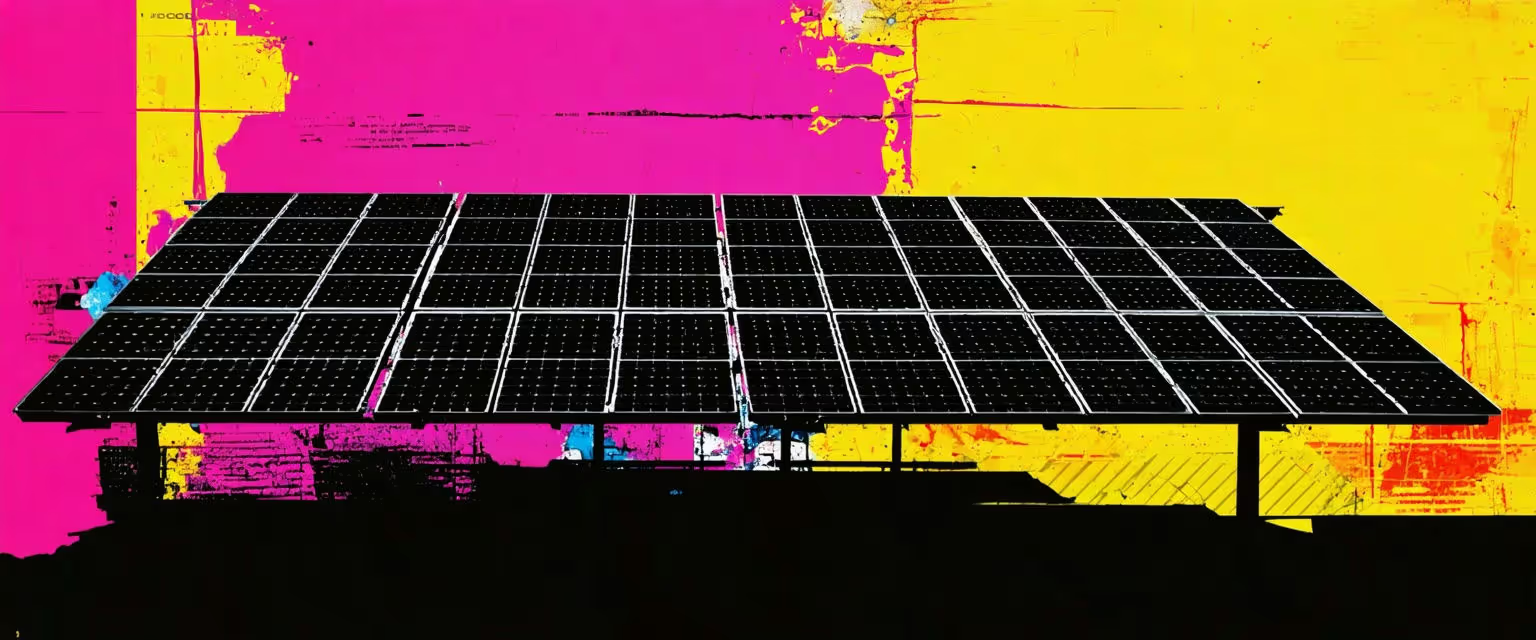All Posts
Construction - AI-Powered Project & Workflow Automation
Revolutionizing Solar Panel Maintenance: How AI Detects Underperformance

Discover how AI agents optimize solar panel performance, detecting underperformance through aerial photos. Enhance efficiency with AI-driven insights and analytics.
Is your team drowning in aerial imagery data that's impossible to process efficiently? As drone technology advances and data volumes explode, construction and engineering companies face the critical problem of extracting meaningful insights from massive amounts of aerial information using traditional methods that simply can't keep pace.
AI and deep learning have emerged as essential solutions to this challenge, creating autonomous systems that can interpret complex imagery to extract actionable insights and dramatically boost operational efficiency. Companies need to move beyond just claiming they're "AI-powered" and implement practical solutions that solve these specific processing challenges—like Datagrid's data connectors that can help transform overwhelming aerial data into valuable business intelligence.
How AI Agents Detect Underperforming Solar Panels from Aerial Photos
Artificial Intelligence (AI) is transforming how we monitor, maintain, and optimize solar energy systems. Advanced algorithms and data analysis techniques are turning traditional solar panel systems into intelligent, self-monitoring networks that maximize energy production while reducing downtime.
AI Technology Overview
AI in solar applications refers to intelligent systems that learn from data, identify patterns, and make decisions with minimal human intervention. These systems use three key technologies:
- Machine Learning: Algorithms that improve through experience, making solar monitoring systems more accurate at predicting issues and optimizing performance over time.
- Predictive Analytics: Statistical techniques that analyze current and historical data to forecast future events, which are particularly useful for maintenance scheduling and energy production forecasting.
- IoT Sensors and Aerial Imaging: Internet of Things devices collecting real-time data from solar installations, and aerial photography providing the raw information AI systems need.
Aerial photos provide visual data to identify physical issues, and AI can revolutionize photo analysis by detecting underperforming panels from these images.
These technologies create comprehensive solar intelligence systems with several critical applications:
- Performance Optimization: AI identifies ways to enhance solar panel performance by analyzing operational data and aerial imagery. If a panel underperforms due to shading from vegetation or soiling, the AI system can recommend trimming or cleaning to improve energy output.
- Site Selection and Design: Machine learning algorithms analyze weather patterns, solar radiation levels, topography, and aerial photos to find optimal locations for solar installations and determine ideal panel arrangements.
- Weather Integration: AI systems connect with weather forecasting data to predict how changing conditions will affect energy production, enabling preemptive adjustments.
- Energy Demand Forecasting: By analyzing historical production data, AI can predict future energy production and demand patterns, helping providers manage resources better.
Process of AI Detection
The AI detection process follows a systematic approach turning raw data into valuable insights with AI:
- Data Collection: IoT sensors gather performance metrics from solar panels, including voltage, current, temperature, and environmental conditions. Aerial photos provide visual data to identify physical issues.
- Data Transmission: Collected information travels to central processing systems, typically through wireless networks, where it's prepared for analysis.
- Pattern Recognition: AI algorithms analyze data and aerial imagery to identify patterns and anomalies indicating potential issues or improvement opportunities, such as:
- Gradual decreases in energy production
- Unusual temperature fluctuations
- Irregular voltage readings
- Visible damage or shading detected from aerial photos
- Performance deviations compared to similar panels
- Predictive Maintenance: Based on detected patterns, AI systems forecast when maintenance will be needed before equipment fails. This predictive capability allows maintenance teams to address issues proactively, preventing costly downtime.
- Fault Detection and Diagnosis: When abnormalities appear, AI can identify the problem and diagnose the specific cause, including:
- Panel degradation
- Inverter malfunctions
- Connection problems
- Physical damage from environmental factors detected via aerial imagery
- Automated Response: Advanced systems can automatically adjust parameters to mitigate issues or schedule maintenance through integrated workflow systems.
- Continuous Learning: AI systems learn from new data and outcomes, improving their detection accuracy and predictive capabilities over time.
This intelligent approach to solar panel analytics, particularly through the analysis of aerial photos, improves daily performance, extends system lifespan, and enhances return on investment, making solar energy more viable as a sustainable power source. As AI technologies advance, we can expect even more sophisticated detection and optimization capabilities.
Benefits of AI in Solar Panel Efficiency
AI is revolutionizing solar technology. Renewable energy sector workers are now actively pursuing digitalization and automation, making AI a cornerstone for advancing solar panel efficiency.
Technical and Operational Advantages
AI enhances solar panel systems through several key technical improvements, significantly boosting efficiency with AI:
- Advanced Data Analysis: AI processes vast amounts of data from solar panel systems, spotting underperforming panels through aerial photographs and performance metrics. It can analyze multiple power plants simultaneously.
- Predictive Maintenance: AI algorithms forecast equipment failure by analyzing operational data patterns and aerial imagery. This proactive approach prevents unexpected downtime and extends solar infrastructure lifespan, cutting maintenance costs significantly.
- Panel Angle Optimization: AI systems adjust solar panel angles to maximize sunlight exposure throughout the day, accounting for seasonal changes and daily sun patterns.
- Weather Forecasting Integration: AI uses historical and real-time weather data to anticipate conditions affecting solar efficiency, enabling timely adjustments to maintain high energy production.
- Fault Detection and Diagnosis: AI quickly identifies root causes of system faults, allowing maintenance teams to address problems promptly and minimize energy production losses.
These technologies can be deployed through two primary approaches:
- Automated Decision-Making: AI systems process information without human interaction, performing complex tasks like scheduling preventive maintenance automatically.
- Aided Decision-Making: Humans make final decisions while AI enhances the process through data analysis—valuable for nuanced judgments like environmental impact assessments.
Environmental and Economic Impact
The economic advantages of AI-enhanced solar systems are substantial:
- Increased Energy Yield: By continuously optimizing panel positioning and operation, and quickly detecting underperforming solar panels from aerial photos, AI-driven systems extract more energy from the same hardware, increasing return on investment.
- Reduced Operational Costs: Predictive maintenance reduces emergency repairs and identifies underperforming components before complete failure.
- Extended System Lifespan: Early detection of potential issues prevents cascading failures that can damage expensive components.
The environmental benefits further enhance the economic advantages. Greater solar efficiency increases renewable energy generation, displacing more fossil fuel-based electricity and reducing emissions. Optimized land use maximizes energy output from existing installations, minimizing the need for new solar farms and preserving land for other purposes. AI-driven maintenance extends solar panel lifespans, reducing resource consumption and waste from replacements. These combined benefits highlight the importance of integrating advanced technologies for sustainable progress.
While initial AI integration involves variable costs depending on system complexity and existing infrastructure, long-term benefits typically outweigh these investments. As solar installation technologies evolve, AI is becoming more accessible for systems of all sizes.
The combination of enhanced technical performance and significant economic benefits makes AI integration increasingly essential for solar energy projects, helping unlock solar energy's full potential and accelerating our transition to sustainable energy.
Challenges and Limitations of AI Technology
Despite AI's promising advantages in solar energy applications, several significant challenges remain before the technology can reach its full potential.
Workforce Training and Expertise Gap
Successful AI implementation requires significant investment in workforce training. Understanding appropriate AI applications is crucial. Despite renewable energy sector workers pursuing digitalization and the benefits of enhancing operational efficiency, a significant knowledge gap remains in effectively implementing and managing AI systems in solar applications.
Technological Limitations
Current AI technologies still struggle with:
- Handling unpredictable weather patterns: While AI can analyze historical weather data, sudden atmospheric changes remain difficult to predict accurately.
- Physical constraints understanding: AI systems have limited grasp of physical world constraints affecting solar panel performance, like dust accumulation, degradation, and microclimate variations—factors often identifiable through aerial photos.
- Cross-system integration: Solar energy often integrates with other renewable and conventional energy sources, creating complex systems current AI tools may struggle to optimize holistically.
To move forward effectively, the solar industry must address these challenges through continued research, careful implementation strategies, and realistic expectations about AI capabilities.
How Agentic AI Simplifies Construction Task Automation
The construction industry faces unique challenges as one of the least digitized sectors globally, struggling with cost overruns, delays, safety issues, and labor shortages. Agentic AI offers a transformative solution by automating repetitive tasks and providing valuable insights that let you focus on higher-level project management.
Automating Documentation Workflows
Agentic AI can transform how you handle construction project documentation. Datagrid's AI agents automate Request for Information (RFI) processing, creating immediate notifications for those open since the previous day and even drafting responses. Project managers can set up automated systems, with AI optimizing task assignments to ensure daily reports are logged by specific times, with focus on identifying potential risks for specific projects.
These AI agents integrate with construction management platforms like Procore, automatically identifying critical issues such as subcontractors with the most rejected submissions across all projects. This saves countless review hours while providing actionable intelligence about project risks.
Enhanced Data Analysis and Insight Discovery
Datagrid's AI agents excel at analyzing complex data sets and extracting meaningful insights. A powerful example is using AI to analyze aerial photographs for detecting underperforming solar panels. This demonstrates how AI agents can identify issues that might go unnoticed by humans, enabling timely interventions. These automated inspections represent just one way AI is transforming construction workflows.
Multi-System Integration for Enhanced Efficiency
What makes agentic AI particularly valuable in construction is its multi-system connection ability. Rather than isolated data silos, Datagrid's multi-LLM compatibility lets you select the most appropriate AI models for various tasks, whether processing safety documentation, analyzing project timelines, or evaluating subcontractor performance.
This integration capability extends to connecting your core construction software with tools like Salesforce for lead management, communication platforms like Slack for automated notifications, and data analysis tools tracking metrics across all systems.
By deploying AI agents to handle routine documentation, monitor project risks, and maintain compliance requirements, you free up valuable time for your team to focus on client relationships, quality control, and strategic decision-making—delivering more successful projects while reducing the administrative burden that has long plagued the construction industry.
Simplify Construction Project Management with Agentic AI
Ready to revolutionize your construction project management with AI-powered automation? Datagrid is your solution for:
- Seamless integration across all major construction platforms (Procore, PlanGrid, BIM 360)
- AI-driven RFP analysis and bid management
- Automated submittal and change order processing
- Real-time project insights and schedule optimization
See how Datagrid can help you increase process efficiency.
Create a free Datagrid account












